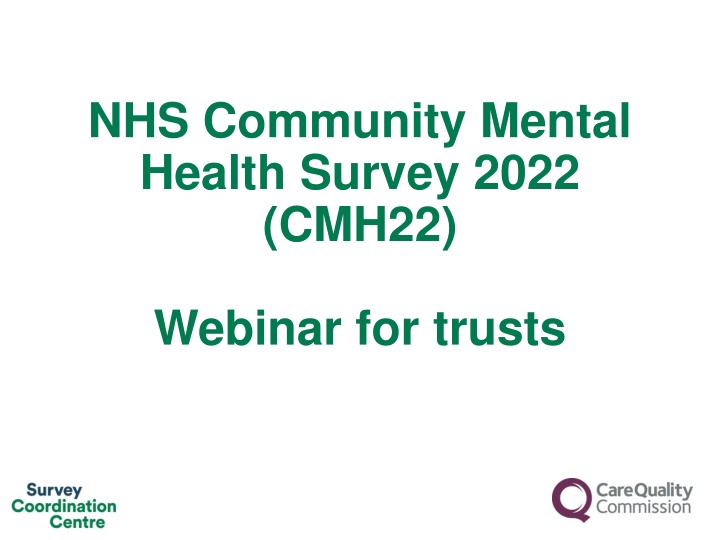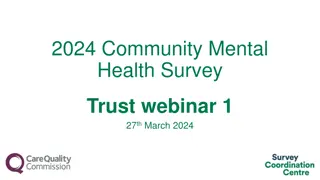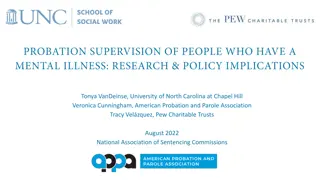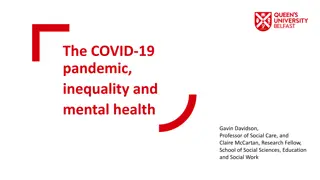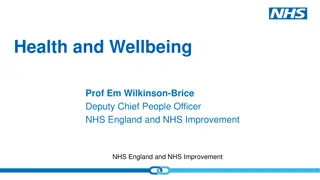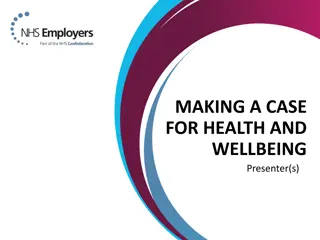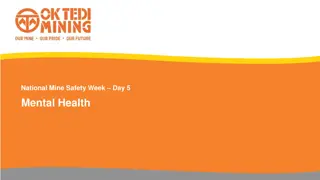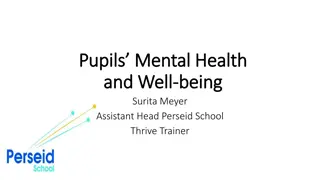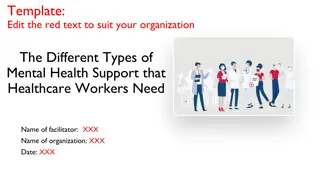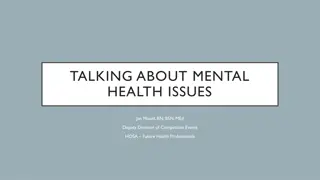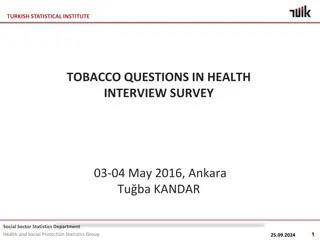NHS Community Mental Health Survey 2022: Webinar Agenda and COVID-19 Implications
The NHS is organizing a webinar for trusts regarding the Community Mental Health Survey 2022 (CMH22). The agenda includes an overview, questionnaire development, data protection requirements, sampling errors, and more. There are also insights on the COVID-19 implications for the survey, such as changes in service provision and sampling criteria. Key details on sample criteria and variables from CMH21 are highlighted.
Download Presentation

Please find below an Image/Link to download the presentation.
The content on the website is provided AS IS for your information and personal use only. It may not be sold, licensed, or shared on other websites without obtaining consent from the author.If you encounter any issues during the download, it is possible that the publisher has removed the file from their server.
You are allowed to download the files provided on this website for personal or commercial use, subject to the condition that they are used lawfully. All files are the property of their respective owners.
The content on the website is provided AS IS for your information and personal use only. It may not be sold, licensed, or shared on other websites without obtaining consent from the author.
E N D
Presentation Transcript
NHS Community Mental Health Survey 2022 (CMH22) Webinar for trusts 1
Agenda Overview of 2022 survey [15 mins] Questionnaire development [10 mins] Data Protection and Section 251 Requirements [5 mins] Potential Sampling Errors [10 mins] DBS checks [5 mins] Instruction Manuals [10 mins] Practical example of how to draw a sample [15 mins] Entering fieldwork [5 mins] Key dates [5 mins] Questions [10 mins] 2
Overview of the 2022 survey 3
COVID-19 implications Implications Risks to CMH Survey due to COVID-19 Displaying dissent posters (recommended also on trust website) Changed service user throughput Service provision changes o o o o Summary of changes Coronavirus questions reviewed and amended/replaced Sampling variable remains as in CMH 21 Sampling criteria remains as in CMH 21 First reminder reverts back to mailing after 5 instead of 7 days (Changed for CMH 21 due to postal delays) Ongoing potential impact on historical comparisons o o o o o 4
Sample criteria unchanged from CMH21 The sample for this survey is a random sample of 1,250 service users who: are aged 18 years and above; AND o were seen by someone face-to-face at your trust or via video conference (e.g. using Attend Anywhere, MS Teams, Zoom etc.) or telephone call between 1st September and 30th November 2021 (the sample period); AND o had at least one other contact (face-to-face, video conference, phone or email) either before, during or after the sampling period. o Service users who were in contact via telephone during the sample period should only be included if that is not their usual mode of care and treatment. If a service user received care and treatment via telephone prior to the pandemic, they are not eligible. 5
Sample variables unchanged from CMH21 Email address indicator not actual email address 0 = no email address held for service user, 1 = email address held for service user, 9 = unsure. Service user full postcode Mode of contact since 1st March 2021 Most commonly used method in which care, treatment and assessment has been delivered since 1st March 2021. Conduct a simple count of each mode to determine which mode was most commonly used. Only include contacts where a service user received care, treatment or assessment, and not to include contacts where a service user was querying an appointment time for example. 1 = face to face contact (i.e. in person), 2 = video conferencing, 3 = telephone, 4 = multiple contact used (this code should only be used when there is no clear most common mode) 5 = unsure.
Reminder mailings changed from CMH21 Royal Mail experienced postal delays due to the pandemic and the first reminder was sent out seven working days after the initial mailing, this is to allow service users time to opt out of the survey. For the CMH22, the time between the initial contact (first mailing letter) and first reminder (second mailing letter) will revert back to five working days (as all previous CMH surveys).
Cover letter changes Changes to covering letters Changes to CQC website address Easy Read option removed (low uptake in CMH21) Letter 3 Transposing two paragraphs, and minor alterations to the wording in them Minor grammatical changes in Letters 1 and 2 8
Other survey materials Accessible questionnaire versions: Braille Large Print Guidance materials Survey Handbook as 2021 Sampling Instructions as 2021 9
(In-house trusts) Accessible questionnaire Logging requests, outcome and data entry 2 outcome codes will be retained: outcome 9= Braille completed questionnaire and outcome 10= Large print completed questionnaire. 1 outcome code no longer in use: outcome 8= Easy Read completed questionnaire. For CMH22 outcome codes to record the number of completions only, and use a separate column to the right to capture the number requested (which is excluded from the response rate). Data Entry o Service users that request braille questionnaire will need to call the freephone helpline number to complete the questionnaire. Respondent answers should be inputted into the main data entry spreadsheet. o Service users that request large print questionnaire will return the completed questionnaire in the freepost envelope. Respondent answers should be inputted into the main data entry spreadsheet. o o o o 10
Questionnaire development 2022 11
Development Process Desk research identifying developments in policy and practice of community mental health service provision Analysis of questionnaire performance using 2021 data Recommendations of Survey Advisory Group Cognitive testing with current service users Consultation with trusts about COVID-19 service provision changes Full details will be available in the Survey Development Report 12
New questions I Your care and treatment section: Key stakeholders identified Choice in the mode of delivery of care as an important topic for inclusion. Q4 was introduced to capture whether service users agreed how their care and treatment would be delivered. 13
New questions II Your care and treatment section: Q5 was introduced to capture the method(s) of care delivery that had been agreed with the service user. 14
New questions III Your care and treatment section: Q6 was introduced to measure whether the service user has received their care and treatment in the way that was agreed. 15
New questions IV Organising your care section: Q14 was introduced to establish if the service user got the help they needed. 16
New questions V Crisis care section: Waiting times for answering crisis care helpline calls was identified as an important topic by key stakeholders this year. Q22 was introduced in order to capture the service user perception of waiting times. 17
Amended questions I Organising your care section: The order of Q12 and Q13 was switched to improve the flow of the questionnaire due to the introduction of the new question (Q14) . 18
Amended questions II Planning your care section: Q15was reworded to focus on whether care had been decided rather than agreed (as in CMH21, Q14 respectively), a new response code Don t know / can t remember was also added. Additional bracketed text was also added for clarification. 19
Amended questions III Planning your care section: Q16 and Q17 were reworded to focus on decision making as opposed to agreement, where Q16 previously referred to agreeing care (Q15 in CMH21) and Q17 previously referred to agreements of care (Q16 in CMH21) 20
Amended questions IV Reviewing your care section: Q18was reworded from specific meeting (as in Q17 in CMH21) to care review meeting for clarification. 21
Amended questions V Crisis care section: Q21was reworded from the last time you tried to contact to you contacted and routing added to all answers in order to ensure that the service users were directed to the new Q22, and the response codes already covered the tried to contact them. 22
Removed questions I Your care and treatment section: Q4 was introduced in CMH21 during the COVID pandemic, and was removed for CMH22 as it was felt that the new questions 4-6 reflected the current COVID situation for service users. 18
Removed questions II Your care and treatment section: Q5 and Q6 were removed as it was identified by stakeholders that these questions were not as relevant to this year s survey as they were in 2021 (during the peak of the pandemic). 19
Removed questions III Medicines section: Q24 was removed due to space limitations. It was identified by stakeholders in 2020 as a question with a high potential for removal if space restrictions decreed that one question should be eliminated. 19
Additional changes Your health and social care section: The introductory text was changed from thinking about the most recent time to referring to last time , as this was consistent with other time frame references in the questionnaire. 20
Additional changes Other comments section: The introductory text was changed from your details to your contact details to clarify what details was referring to. 20
Data protection and Section 251 requirements 28
General Data Protection Regulation (GDPR) How patient s personal data is being protected under the GDPR is stated on the reverse side of the covering letter for mailing 1 and 3: 29
Section 251 requirements: dissent posters Dissent posters give potential participants the opportunity to opt out of the survey, available on the NHS Surveys website. Posters should have been displayed during the sampling months (September to November 2021) to comply with S251 requirements. With the exception of the trust information box, it is not permitted to alter the poster in any way this would invalidate the survey s S251 approval. In the box provided, a telephone number must be provided. In addition, an email and a postal address should be provided if they are available. 30
Section 251 requirements We request you publicise the survey both internally and externally to ensure service users are aware of the survey and have the opportunity to opt-out should they wish. Example materials are available in the 'Publicising survey document. Ensure a log of service users who have dissented from taking part in the survey is accurately kept. Ensure the total number of eligible service users who have dissented from the sharing of their details for any purpose other than their clinical care or who have dissented from taking part in the survey specifically are recorded in Section A of your sample declaration form and are excluded from your sample. Section 251 allows patient data to be shared outside of NHS trusts without gaining prior and explicit consent from these patients. 31
National Data Opt-Out Programme NPSP received exemption from National Data Opt-out Programme. Continued separate opt-out mechanisms. Service users do not have to actively consent to the sharing of their data (for the Community Mental Health Survey 2022).
Implications of major errors Survey data is used by CQC to monitor quality of care within each provider. If a major error occurs and it cannot be rectified, implications are as follows: The lack of assurance would be flagged to inspectors for your trust. No data would be provided to NHSE&I for their ongoing monitoring work. No historical comparisons would be provided for your trust in the current survey report if a major error is found to have occurred in your 2022 data. For detailed information on sampling errors see the 2021 Sampling Errors Report. 34
Sample Declaration Form Can help avoid errors. Avoiding errors will ensure your questionnaires can be mailed out earlier and your data will be usable in this year s survey. Includes: o Sample Figures o Checklist (with list of CCG codes) o Declaration Agreement To be signed by person drawing sample and Caldicott Guardian Tip: Take care to fill in dates Tip: Schedule time for sign-off in advance with Caldicott Guardian Submission Sample declaration form to be submitted to your contractor or to the Survey Coordination Centre for Existing Methods (SCCEM) for in-house trusts the sample declaration form has been approved please submit your sample safely via secure file transfer site. Once 35
3 and 5 digit CCG Codes CCG codes updated on website on 26th November 21 New CCG Code NHS Bedfordshire, Luton and Milton Keynes CCG M1J4Y NHS Hampshire, Southampton and Isle of Wight CCG D9Y0V NHS Frimley CCG D4U1Y NHS North East London CCG A3A8R NHS North West London CCG W2U3Z NHS Shropshire, Telford and Wrekin CCG M2L0M NHS Black Country and West Birmingham CCG D2P2L NHS Coventry and Warwickshire CCG B2M3M NHS Kirklees CCG X2C4Y 36
Potential Errors - How to avoid them Examples of checks you should do before submitting your sample: Have you included all service users whose other contact was before, during or after the sampling period? Have you included service users with an unknown care cluster code (code 99 )? Are there any errors in the query used to extract the eligible population? Are there any missing/incomplete data in your initial database? Be aware of system migrations. Make sure you have randomly sampled. Ensure your trust uses an opt-out consent model. For more information, please see the 2021 Community Mental Health Survey Sampling Errors Report 37
DBS Checks 38
DBS Checks Before mailing 1: Demographic Batch Service (DBS) checks are required alongside local checks for deceased patients. Before mailing 2: Only local checks are required* (DBS checks strongly recommended before mailing 2) Before mailing 3: Only local checks are required* (DBS checks strongly recommended before mailing 3) *DBS checks may be undertaken before mailing 2 and 3 however local checks must be undertaken at a minimum. 39
Instruction Manuals - Survey Handbook For survey leads Brief document Survey specific Key summary document that links to all other relevant information: What s new for this year/survey Tips on managing the survey Key dates: Top level Highlights on key information (Section 251, etc.)
Instruction Manuals - Sampling Instructions For sample drawers (data team) Detailed information Overview of CMH22: Additional sample variables as in CMH21: email address indicator, full postcode, mode of contact since 1st March 2021. Survey specific Step-by-step instructions on how to draw sample Flowchart Links to relevant information
Generic NPSP Instruction Documents Patient feedback and the NHS Constitution 1) Setting up a project team 2) Data protection and confidentiality 3) Ethical issues, ethical committees and research 4) governance Separate PDF documents on NHS Surveys website Collecting data from non-English speaking populations 5) Publicising the survey 6) Implementing the survey practicalities 7) Submitting samples 8) Entering and submitting final data 9) Making sense of the data 10) Reporting results 11) Universal glossary 12)
For a practical example of how to draw CMH sample please play video 1 to 4 in order
Entering fieldwork early / on time Entering fieldwork on time or earlier will help your trust to maximise responses from younger and Black and minority ethnic (BME) groups. You will also likely receive an overall higher response rate, providing your trust with more data. Ensure you have a survey team in place before you start drawing your sample. Generate your sample promptly - begin preparing now. Respond to queries as soon as possible to avoid unnecessary delays. Ensure there is sufficient resourcing around the time of drawing your sample and answering queries communicate with your team, handover tasks if people are going to be on leave and let your contractor and the SCCEM know any updates. If there are any changes in the survey lead, inform your contractor and the Survey Coordination Centre for Existing Methods. 46
Key Dates 47
Key dates overview Task Display of dissent posters Survey materials published Questionnaire and cover letters published PDFs of materials submitted to SCCEM, before printing (Contractors and in-house trusts only) Hard copies of materials submitted to SCCEM Deadline for contractors and in-house trusts to submit samples to the SCCEM SCCEM to contact late trusts CQC to contact late trusts Fieldwork (Contractors and in-house trusts only) Weekly monitoring Date September to November 2021 December 2021 Early January 2022 17th January 2022 26th January 2022 9th February 2022 10th February 2022 21st February 2022 14th February - 17th June 2022 Every Thursday during fieldwork, starting 17th February 2022 Soon after the start of fieldwork after first mailing Deadline: 26th March 2022 24th June 2022 (Contractors and in-house trusts only) Send two scanned completed questionnaires to the SCCEM (Contractors and in-house trusts) Deadline for final data 48
Questions? 49
Thank you for your time Copy of the slides will be on the NHS Surveys website Contact us: mentalhealth@surveycoordination.com 01865 208127 50
